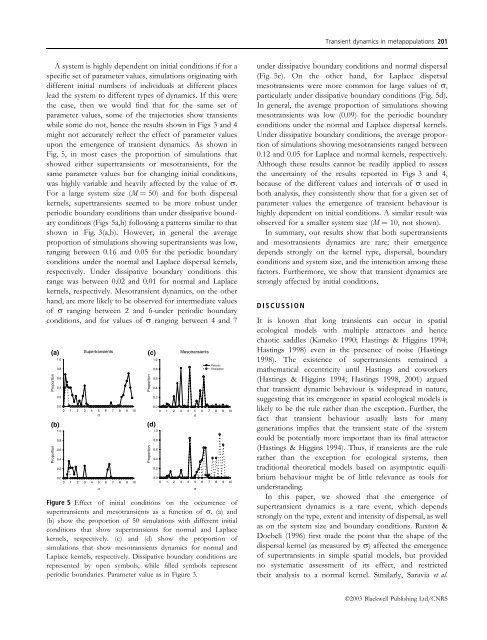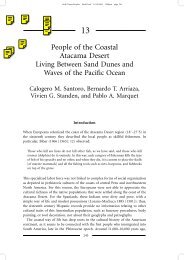Dispersal and transient dynamics in metapopulations - IEB
Dispersal and transient dynamics in metapopulations - IEB
Dispersal and transient dynamics in metapopulations - IEB
Create successful ePaper yourself
Turn your PDF publications into a flip-book with our unique Google optimized e-Paper software.
Transient <strong>dynamics</strong> <strong>in</strong> <strong>metapopulations</strong> 201A system is highly dependent on <strong>in</strong>itial conditions if for aspecific set of parameter values, simulations orig<strong>in</strong>at<strong>in</strong>g withdifferent <strong>in</strong>itial numbers of <strong>in</strong>dividuals at different placeslead the system to different types of <strong>dynamics</strong>. If this werethe case, then we would f<strong>in</strong>d that for the same set ofparameter values, some of the trajectories show <strong>transient</strong>swhile some do not, hence the results shown <strong>in</strong> Figs 3 <strong>and</strong> 4might not accurately reflect the effect of parameter valuesupon the emergence of <strong>transient</strong> <strong>dynamics</strong>. As shown <strong>in</strong>Fig. 5, <strong>in</strong> most cases the proportion of simulations thatshowed either super<strong>transient</strong>s or meso<strong>transient</strong>s, for thesame parameter values but for chang<strong>in</strong>g <strong>in</strong>itial conditions,was highly variable <strong>and</strong> heavily affected by the value of r.For a large system size (M ¼ 50) <strong>and</strong> for both dispersalkernels, super<strong>transient</strong>s seemed to be more robust underperiodic boundary conditions than under dissipative boundaryconditions (Figs 5a,b) follow<strong>in</strong>g a patterns similar to thatshown <strong>in</strong> Fig. 3(a,b). However, <strong>in</strong> general the averageproportion of simulations show<strong>in</strong>g super<strong>transient</strong>s was low,rang<strong>in</strong>g between 0.16 <strong>and</strong> 0.05 for the periodic boundaryconditions under the normal <strong>and</strong> Laplace dispersal kernels,respectively. Under dissipative boundary conditions thisrange was between 0.02 <strong>and</strong> 0.01 for normal <strong>and</strong> Laplacekernels, respectively. Meso<strong>transient</strong> <strong>dynamics</strong>, on the otherh<strong>and</strong>, are more likely to be observed for <strong>in</strong>termediate valuesof r rang<strong>in</strong>g between 2 <strong>and</strong> 6-under periodic boundaryconditions, <strong>and</strong> for values of r rang<strong>in</strong>g between 4 <strong>and</strong> 7(a)(b)Figure 5 Effect of <strong>in</strong>itial conditions on the occurrence ofsuper<strong>transient</strong>s <strong>and</strong> meso<strong>transient</strong>s as a function of r. (a) <strong>and</strong>(b) show the proportion of 50 simulations with different <strong>in</strong>itialconditions that show super<strong>transient</strong>s for normal <strong>and</strong> Laplacekernels, respectively. (c) <strong>and</strong> (d) show the proportion ofsimulations that show meso<strong>transient</strong>s <strong>dynamics</strong> for normal <strong>and</strong>Laplace kernels, respectively. Dissipative boundary conditions arerepresented by open symbols, while filled symbols representperiodic boundaries. Parameter value as <strong>in</strong> Figure 3.(c)(d)under dissipative boundary conditions <strong>and</strong> normal dispersal(Fig. 5c). On the other h<strong>and</strong>, for Laplace dispersalmeso<strong>transient</strong>s were more common for large values of r,particularly under dissipative boundary conditions (Fig. 5d).In general, the average proportion of simulations show<strong>in</strong>gmeso<strong>transient</strong>s was low (0.09) for the periodic boundaryconditions under the normal <strong>and</strong> Laplace dispersal kernels.Under dissipative boundary conditions, the average proportionof simulations show<strong>in</strong>g meso<strong>transient</strong>s ranged between0.12 <strong>and</strong> 0.05 for Laplace <strong>and</strong> normal kernels, respectively.Although these results cannot be readily applied to assessthe uncerta<strong>in</strong>ty of the results reported <strong>in</strong> Figs 3 <strong>and</strong> 4,because of the different values <strong>and</strong> <strong>in</strong>tervals of r used <strong>in</strong>both analysis, they consistently show that for a given set ofparameter values the emergence of <strong>transient</strong> behaviour ishighly dependent on <strong>in</strong>itial conditions. A similar result wasobserved for a smaller system size (M ¼ 10, not shown).In summary, our results show that both super<strong>transient</strong>s<strong>and</strong> meso<strong>transient</strong>s <strong>dynamics</strong> are rare; their emergencedepends strongly on the kernel type, dispersal, boundaryconditions <strong>and</strong> system size, <strong>and</strong> the <strong>in</strong>teraction among thesefactors. Furthermore, we show that <strong>transient</strong> <strong>dynamics</strong> arestrongly affected by <strong>in</strong>itial conditions.DISCUSSIONIt is known that long <strong>transient</strong>s can occur <strong>in</strong> spatialecological models with multiple attractors <strong>and</strong> hencechaotic saddles (Kaneko 1990; Hast<strong>in</strong>gs & Higg<strong>in</strong>s 1994;Hast<strong>in</strong>gs 1998) even <strong>in</strong> the presence of noise (Hast<strong>in</strong>gs1998). The existence of super<strong>transient</strong>s rema<strong>in</strong>ed amathematical eccentricity until Hast<strong>in</strong>gs <strong>and</strong> coworkers(Hast<strong>in</strong>gs & Higg<strong>in</strong>s 1994; Hast<strong>in</strong>gs 1998, 2001) arguedthat <strong>transient</strong> dynamic behaviour is widespread <strong>in</strong> nature,suggest<strong>in</strong>g that its emergence <strong>in</strong> spatial ecological models islikely to be the rule rather than the exception. Further, thefact that <strong>transient</strong> behaviour usually lasts for manygenerations implies that the <strong>transient</strong> state of the systemcould be potentially more important than its f<strong>in</strong>al attractor(Hast<strong>in</strong>gs & Higg<strong>in</strong>s 1994). Thus, if <strong>transient</strong>s are the rulerather than the exception for ecological systems, thentraditional theoretical models based on asymptotic equilibriumbehaviour might be of little relevance as tools forunderst<strong>and</strong><strong>in</strong>g.In this paper, we showed that the emergence ofsuper<strong>transient</strong> <strong>dynamics</strong> is a rare event, which dependsstrongly on the type, extent <strong>and</strong> <strong>in</strong>tensity of dispersal, as wellas on the system size <strong>and</strong> boundary conditions. Ruxton &Doebeli (1996) first made the po<strong>in</strong>t that the shape of thedispersal kernel (as measured by r) affected the emergenceof super<strong>transient</strong>s <strong>in</strong> simple spatial models, but providedno systematic assessment of its effect, <strong>and</strong> restrictedtheir analysis to a normal kernel. Similarly, Saravia et al.Ó2003 Blackwell Publish<strong>in</strong>g Ltd/CNRS
















